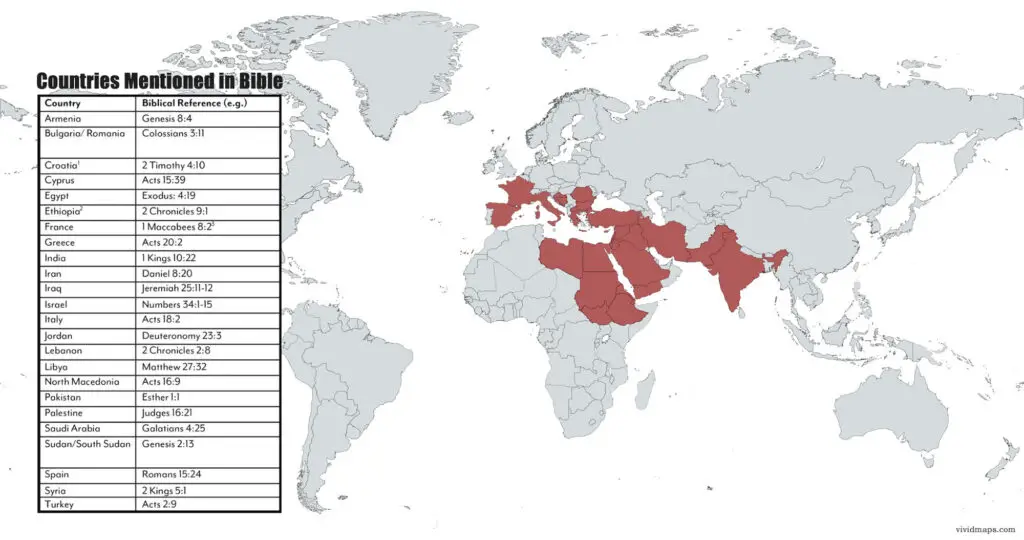A World Map of All the Countries Mentioned in the Bible
Picture a world where history is told through stories passed down generations, where geography is less about precise boundaries and more about the rich narratives that connect human experiences. This is the world of biblical lands—a complex, vibrant landscape that continues to fascinate historians, theologians, and curious minds alike.
Isaac Asimov once observed something profound about the Bible’s historical significance: for centuries, this text was virtually the only historical record that most people knew (Isaac Asimov, “Guide to the Bible”, 1967 – Amazon link). It’s a startling thought. Imagine a world where your understanding of ancient civilizations comes primarily from a single, centuries-old text.
Take Nebuchadnezzar, for instance. Most people today know his name not from comprehensive historical studies, but because he’s prominently featured in biblical narratives. Meanwhile, equally significant historical figures like Pericles remain obscure to the general public. This selective historical memory reveals how powerful storytelling can shape our collective understanding of the past.
Consider Ecbatana, today a provincial capital in Iran, but once the heart of the Median Empire. For most people, its primary claim to fame is a brief mention in the biblical Book of Tobit. Yet this city has witnessed millennia of human civilization, its stories far richer than a single biblical reference might suggest.
The geographical landscape of biblical times was remarkably different from our modern conception of nation-states. Persia—now Iran—was once a massive empire that played a crucial role in regional history. The Bible celebrates King Cyrus the Great, even granting him the extraordinary title of “messiah” for ending the Jewish exile and returning people to their homeland (Book of Isaiah, Chapter 45).
Remarkably, several modern countries trace their geographical roots directly to biblical lands. Egypt, Lebanon, Israel, Cyprus, Greece, Italy, and Spain all exist in forms recognizable to ancient storytellers.

This world map unveils a surprising geographical revelation: biblical references span an incredible range of countries, from the well-known to the unexpected. From the ancient empires of Egypt and Iran to the lesser-known biblical mentions of France and Croatia, these lands tell a story far more intricate than many might expect.
Armenia appears in Genesis 8:4, referenced in the story of Noah’s Ark, where the biblical narrative suggests the ark came to rest on the mountains of Ararat. Today, these mountains straddle the border between modern Armenia and Turkey, linking ancient mythology with contemporary geography.
France might surprise many, but it’s mentioned in 1 Maccabees 8:23, revealing the complex diplomatic relations of ancient times. Similarly, Croatia receives a brief biblical mention in 2 Timothy 4:10, a testament to the far-reaching connections of early Christian communications.
Some countries carry profound historical significance. Ethiopia, mentioned in 2 Chronicles 9:1, represents one of the oldest continuous civilizations, with biblical references highlighting its historical importance. India appears in 1 Kings 10:22, suggesting sophisticated trade networks that existed thousands of years ago.
The geopolitical landscape of biblical times was remarkably different from our modern understanding. Countries like Syria, Iraq, and Jordan were cradles of complex civilizations, their biblical mentions offering glimpses into intricate historical narratives. North Macedonia, referenced in Acts 16:9, represents the crossroads of ancient cultural exchanges.
Cyprus, mentioned in Acts 15:39, emerges as a critical location in early Christian missionary journeys, highlighting the Mediterranean’s role in spreading new religious ideas. Libya’s appearance in Matthew 27:32 provides a brief but intriguing glimpse into the multicultural landscape surrounding Jerusalem.
Saudi Arabia’s reference in Galatians 4:25 connects to the profound story of Hagar and Ishmael, revealing how biblical narratives intertwine with geographical locations. The mention links ancient familial stories to a specific regional context, demonstrating the deep geographical roots of biblical narratives.
Even more fascinating are the countries that might seem unexpected in a biblical context. Pakistan, mentioned in the Book of Esther, reveals the extensive reach of ancient empires. The biblical references show a world far more interconnected than many might imagine.
What makes these ancient lands so compelling? It’s the intersection of geography, culture, and storytelling. Each location mentioned in biblical texts isn’t just a point on a map, but a complex ecosystem of human experiences, migrations, conflicts, and connections.
Historians like Tommy Trelawny remind us that while modern nation-states are relatively recent constructs, the regions they occupy have rich, interconnected histories that far predate our current political boundaries.
For those fascinated by the intersection of ancient history, geography, and biblical scholarship, here are some Amazon resources to explore further:
We’re curious to hear from you! What historical lands fascinate you most? Have you visited any biblical sites? Share your thoughts and experiences in the comments below.








